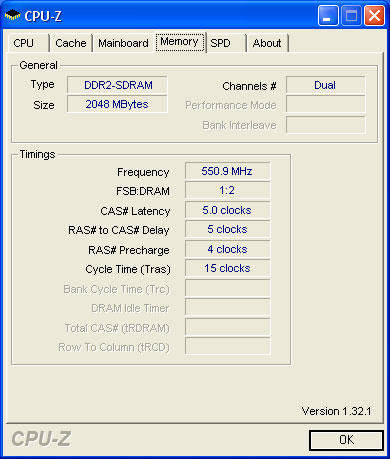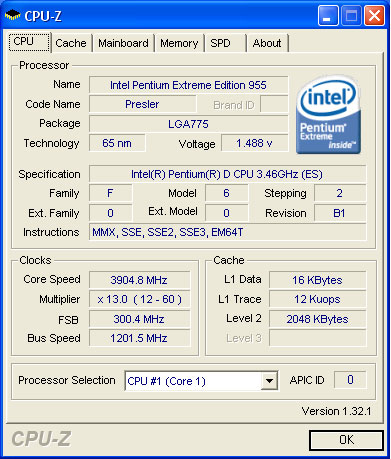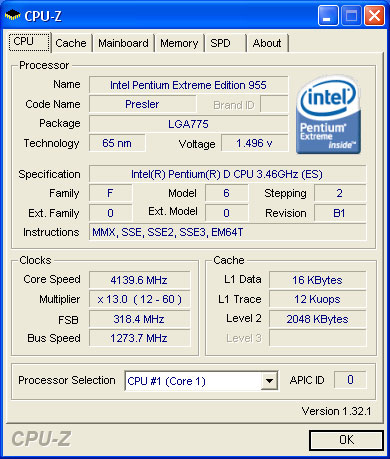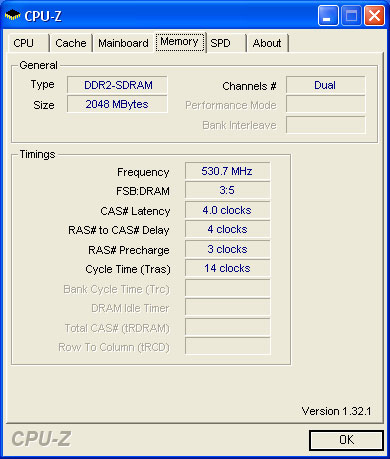OCZ EL PC2-8000 XTC: Low Latency PLUS DDR2-1100
by Wesley Fink on April 3, 2006 12:01 AM EST- Posted in
- Memory
Stock Memory Performance
As discussed in earlier DDR2 memory reviews, the Intel platform does not really allow for easily testing different memory speeds at the same CPU speed. Instead most top motherboards provide a wide range of memory ratios that match available DDR2 memory. Most end-users can therefore select the memory ratio that matches their DDR2 memory speed. For those reasons, we first tested all of the stock ratios at the fastest stable timings we could achieve at the given ratio. With ratios, CPU speed remains the same at 3.46GHz in our memory test bed, and memory speed is varied by selecting different ratios.
Since the OCZ PC2-8000 EL is rated at DDR2-1000, the 1000 speed was also tested. To achieve that speed the 889 memory speed was selected at the standard 1066 FSB (266 setting quad pumped). The FSB was then overclocked to 300 (1200 FSB) resulting in a memory speed of DDR2-1000. You can clearly see that the OCZ PC2-8000 EL performed much better than the rated timings of 4-4-5-15. Our testing found complete stability at DDR2-1000 at 4-3-4-12 timings.
In the introduction it was pointed out that the fastest possible timings with today's DDR2 are 3-2-2. If you look closely you will see the OCZ PC2-8000 works fine at the fastest timings that can be selected at both DDR2-400 and the 1:1 memory setting of DDR2-533. These are both the fastest timings we have ever been able to run with complete stability with DDR2. In fact all the way up to DDR2-1066 this new PC2-8000 memory sets new records for the lowest latencies we have found in testing DDR2 memory.
Despite the fact that CPU multipliers can not be dropped below 12X on the Intel platform, it is important to keep in mind that the first 5 table rows, from DDR2-400 to DDR2-1066, represent a constant CPU speed of 3.46GHz with memory running at faster speeds through ratios. 1:1 should always have the least overhead in the current Intel universe, but the DDR2 memory still scales well with speed over the full range. Memory bandwidth improves with memory speed, as does raw calculation performance. However, this does not always translate into linear gaming performance curves in Half Life 2: Lost Coast and Far Cry.
There are other possible approaches to overclocking DDR2 memory on the Intel platform. Probably the most logical, given the memory controller resides on the Intel chipset rather than the processor, is to look at overclocking at a 1:1 ratio. For our test setup that means a DDR2-533 base setting. You can see results of that approach on page 10.
As discussed in earlier DDR2 memory reviews, the Intel platform does not really allow for easily testing different memory speeds at the same CPU speed. Instead most top motherboards provide a wide range of memory ratios that match available DDR2 memory. Most end-users can therefore select the memory ratio that matches their DDR2 memory speed. For those reasons, we first tested all of the stock ratios at the fastest stable timings we could achieve at the given ratio. With ratios, CPU speed remains the same at 3.46GHz in our memory test bed, and memory speed is varied by selecting different ratios.
| OCZ EL PC2-8000 XTC (Stock Memory Ratios) - 2x1GB Double-Bank | |||||||
| CPU Ratio at 3.47 GHz |
Memory Speed |
Best Memory Timings (Voltage) |
Far Cry (fps) |
Sandra Unbuffered |
Sandra Standard Buffered |
SuperPi Mod 1.4 2M places (time in sec) |
Half Life 2: Lost Coast (fps) |
| (4:3) | 400 DDR2 |
3-2-2-6 1T 1.8V |
61.5 | INT 3001 FLT 3037 |
INT 5614 FLT 5608 |
87.6 | 75.6 |
| (1:1) | 533 DDR2 |
3-2-2-9 1T 2.1V |
63.07 | INT 3570 FLT 3600 |
INT 6500 FLT 6498 |
85.3 | 84.2 |
| (4:5) | 667 DDR2 |
3-2-3-10 1T 2.1V |
63.07 | INT 3999 FLT 3995 |
INT 6710 FLT 6691 |
84.7 | 83.4 |
| (2:3) | 800 DDR2 |
3-3-3-11 1T 2.1V |
64.52 | INT 4301 FLT 4356 |
INT 6774 FLT 6788 |
83 .3 | 81.7 |
| (1:2) | 1066 DDR2 |
4-4-5-14 1T 2.3V |
64.38 | INT 4576 FLT 4639 |
INT 6840 FLT 6843 |
82.1 | 81.2 |
| *Rated Speed Overclocked 3:5 (300x13) |
1000 DDR2* | 4-3-4-12 1T 2.2V |
64.75 | INT 4982 FLT 5046 |
INT 7649 FLT 7654 |
72.9 | 95.2 |
| Highest Performance Overclocked 3:5 (318x13) |
1060 DDR2 | 4-3-4-14 1T 2.3V |
75.06 | INT 5260 FLT 5303 |
INT 8105 FLT 8107 |
69.1 | 96.7 |
| Highest Mem Speed Overclocked 1:2 (275x13) |
1100 DDR2 | 5-4-5-15 1T 2.35V |
66.21 | INT 4720 FLT 4785 |
INT 6952 FLT 6947 |
80.2 | 89.8 |
Since the OCZ PC2-8000 EL is rated at DDR2-1000, the 1000 speed was also tested. To achieve that speed the 889 memory speed was selected at the standard 1066 FSB (266 setting quad pumped). The FSB was then overclocked to 300 (1200 FSB) resulting in a memory speed of DDR2-1000. You can clearly see that the OCZ PC2-8000 EL performed much better than the rated timings of 4-4-5-15. Our testing found complete stability at DDR2-1000 at 4-3-4-12 timings.
In the introduction it was pointed out that the fastest possible timings with today's DDR2 are 3-2-2. If you look closely you will see the OCZ PC2-8000 works fine at the fastest timings that can be selected at both DDR2-400 and the 1:1 memory setting of DDR2-533. These are both the fastest timings we have ever been able to run with complete stability with DDR2. In fact all the way up to DDR2-1066 this new PC2-8000 memory sets new records for the lowest latencies we have found in testing DDR2 memory.
Despite the fact that CPU multipliers can not be dropped below 12X on the Intel platform, it is important to keep in mind that the first 5 table rows, from DDR2-400 to DDR2-1066, represent a constant CPU speed of 3.46GHz with memory running at faster speeds through ratios. 1:1 should always have the least overhead in the current Intel universe, but the DDR2 memory still scales well with speed over the full range. Memory bandwidth improves with memory speed, as does raw calculation performance. However, this does not always translate into linear gaming performance curves in Half Life 2: Lost Coast and Far Cry.




There are other possible approaches to overclocking DDR2 memory on the Intel platform. Probably the most logical, given the memory controller resides on the Intel chipset rather than the processor, is to look at overclocking at a 1:1 ratio. For our test setup that means a DDR2-533 base setting. You can see results of that approach on page 10.










16 Comments
View All Comments
plewis00 - Monday, April 3, 2006 - link
If Half-Life 2 was producing anomalous results why didn't you replace it when you suspected a problem with some other game instead. Because haven't you now voided your HL2 benchmarks effectively?Wesley Fink - Monday, April 3, 2006 - link
The HL2 Lost Coast results were consistnet for this round of tests, but they did not compare well to earlier test results. We have now discovered the benchmarking issue and the HL2 results will be updated as soon as testing is complete.Earlier tests were run with HDR (High Dynamic Range) enabled, while current tests were run with HDR disabled. We are now testing with HDR enabled.
Avalon - Monday, April 3, 2006 - link
You guys need to do something about those memory setting charts. The ones where you display the different timings you could achieve at different FSB settings for a particular memory...mainly, the part where you have "highest performance" I find misleading, because you have increased the CPU speed, so it almost makes it look like the performance results you have next to the settings are getting a huge boost in performance by going from one setting to the next, when it's really the CPU speed causing that.Maybe make a note on the chart stating that at highest performance mode, the CPU speed has been increased.
Other than that, not a bad review. Good memory, it seems.
Wesley Fink - Monday, April 3, 2006 - link
The information on which values were overclocked was already in the table, but we revised the chart to try to make the Overclocked values stand out more and to clearly identify the stock performance speeds and values.SnoMunke - Monday, April 3, 2006 - link
Interesting article...now about the grammar..."OCZ EL PC2-8000 is the best performing DDR2 memory we have ever tested, clearly outperforming any DDR2 that has been tested at AnandTech."
Wesley Fink - Monday, April 3, 2006 - link
An edited sentence and the original sentence got accidentally combined. Thanks for pointing this out. It is now corrected.